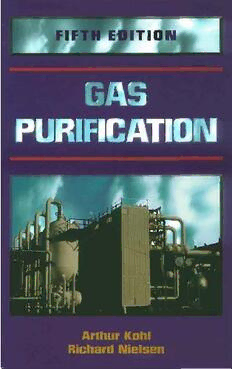
Gas Purification PDF
Preview Gas Purification
I I Arthur Kohl Richard Nielsen F I F T H E D I T I O N Gulf Publishing Company Houston, Texas I Arthur 1. Kohl Richard B. Nielsen F I F T H E D I T I O N GAS PURIFICATION Copyright Q 1960,1974,1979,1985,199b7y Gulf Publishing Company, Houston, Texas. All rights reserved. printed in the United States of America This book, or parts thereof, may not be reproduced in any form without permission of the publisher. Gulf Publishing Company Book Division P.O. BOX2 608 0 HOUS~OTIIe, xa~7 7252-2608 10 9 8 7 6 5 4 3 Library of Congress Cataloging-h-Publication Data Kohl, Arthur L - Gas purification. 5th ed. /Arthur Kohl and Richard Nielsen. p. cm. Includes bibliographical references and index. ISBN 0-88415-220-0 1. Gases-fification. I. Nielsen, Richard (Richard B.) II. Title. TP754.K6 1997 665.7421 9652470 CIP iv Preface, vii Chapter 1 Introduction, 1 Chapter 2 Alkanolamines for Hydrogen Sulfide and Carbon Dioxide Removal, 40 Chapter 3 Mechanical Design and Operation of Alkanolamine Plants, 187 Chapter 4 Removal and Use of Ammonia in Gas Purification, 278 Chapter 5 Alkaline Salt Solutions for Acid Gas Removal, 330 Chapter 6 Water as an Absorbent for Gas Impurities, 41 5 Chapter 7 Sulfur Dioxide Removal, 466 Chapter 8 Sulfur Recovery Processes, 670 Chapter 9 liquid Phase Oxidation Processes for Hydrogen Sulfide Removal, 731 V Chapter 10 Control of Nitrogen Oxides, 866 Chapter 11 Absorption of Water Vapor by Dehydrating Solutions, 946 Chapter 12 Gas Dehydration and Purification by Adsorption, 1022 Chapter 13 Thermal and Catalytic Conversion of Gas Impurities, 1136 Chapter 14 Physical Solvents for Acid Gas Removal, 1187 Chapter 15 Membrane Permeation Processes, 1238 Chapter 16 Miscellaneous Gas PurificationT echniques, 1296 Appendix, 1374 Index, 1376 vi The first four editions of Gas Purijication were authored by Arthur L. Kohl and Fred C. Riesenfeld. hh. Riesenfeld died shady after publication of the fourth edition in 1985. His considerable technical contributions and warm friendship will be sorely missed. The present team of authors has endeavored to completely overhaul and update the text for publication as this fifth edition of Gas Punjication. Three new chapters have been added to cover the rapidly expanding fields of NO, control (Chapter IO), absorption in physical sol- vents (Chapter 14), and membrane permeation (Chapter 15). All other chapters have been expanded, revised, and rearranged to add new subject matter, delete obsolete material, and provide increased emphasis in areas of strong current interest. Examples of major additions to existing chapters are the inclusion of new sections on liquid hydrocarbon treating (Chapter 2), Claus plant tail gas treating (Chapter 8), biofilters for odor and volatile organic com- pound (VOC) control (Chapter 12), thermal oxidation of VOCs (Chapter 13), and sulfur scavenging processes (Chapter 16). Because of the growing importance of air pollution control, the coverage of gas purifica- tion technologies that are applicable in this field, such as SO2, NO,, and VOC removal, has been expanded considerably. On the other hand, the use of ammonia for H2S and COz removal and the removal of ammonia from gas streams represent technologies of decreasing importance, primarily because of the declining use of coal as a source of fuel gas. Discus- sions of these two subjects have, therefore, been combined into a single chapter (Chapter 4). Organization of the text represents a pctical compromise between an arrangement based on unit operations or process similarities and one based on impurities being removed. Thus, Chapters 12 and 15 cover the operations of adsorption and membrane permeation, respec- tively, and the use of these technologies for the removal of a wide variety of impurities; while Chapters 7 and 10 cover single impurities (SOz and NO,, respectively) and their removal by a number of different processes. Consideration is also given to the industrial importance of the technologies in the allocation of chapters; as a result, two chapters (Chap- ters 2 and 3) are devoted to the use of amines for the removal of H2S and COz, while only one, rather short chapter (Chapter 6) covers the use of water for the absorption of gas impuri- ties of any type. The aim of this book is to provide a practical engineering description of techniques and processes in widespread use and, where feasible, provide sufficient design and operating data to permit evaluation of the processes for specific applications. Limited data on processes that were once, but are no longer commercially important, are also presented to pvide an histor- ical perspective. Subject matter is generally limited to the removal from gas streams of gas- phase impurities that are present in relatively minor proportions. The removal of discrete sol- id or liquid particles is not discussed, nor are processes that would more appropriately be classified as separation rather than purification. A generalized discussion of absorption is provided in Chapter 1 because this unit opera- tion is common to so m yof the processes described in subsequent chapters. Discussions of other unit operations employed in gas purification processes, such as adsorption, catalytic
